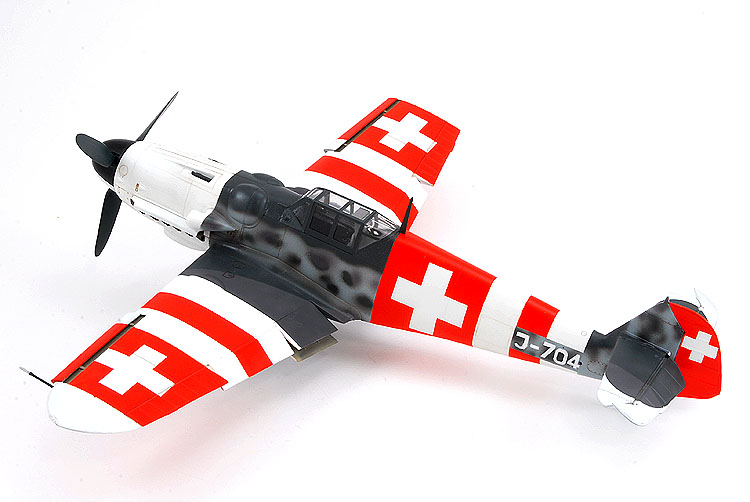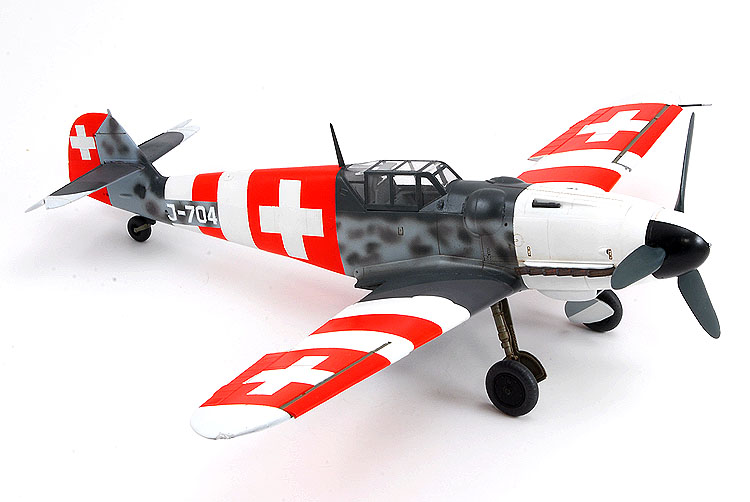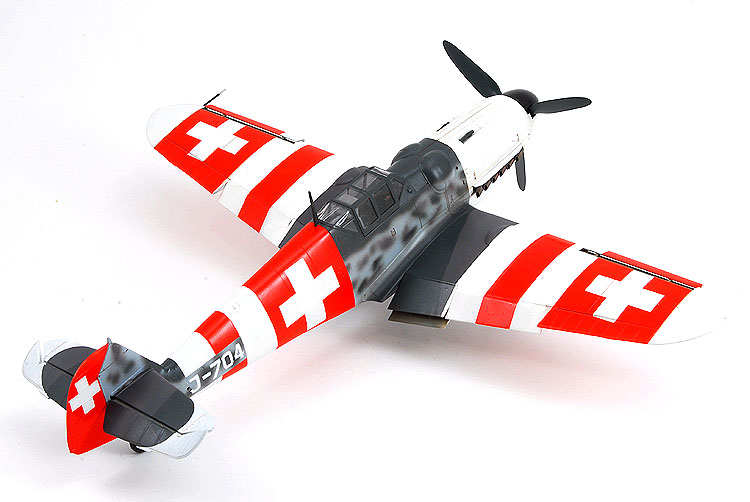

It's certainly the most colourful Bf 109 I've ever seen, but it's still a Messerschmitt - an airplane that leaves me unexcited.
Kit:
Aftermarket:
Date:
Hasegawa (ST17)
None
2002
Yes for all of you out there in Messerschmitt land, this article isn’t about the wondrous history of Willy Messerschmitt’s designs, but rather my un-scientific exploration into what
makes a great model kit (according to the Internet ‘experts’). But first some background.
I’m not a fan of the Bf 109, but I am willing to build one when it suits my collection (as with my Battle of Britain E-3) or when I want to compare notes with other modelers (like
this kit). I too am not a fan of German camouflage so I set off to build a Swiss Air Force machine from the start.
Before the war began, the Swiss Air Force purchased a number of export versions of the Bf 109E for that countries’ own defense. Although these machines didn’t even include pilot
armor, they were highly used over the next few years; escorting damaged Allied aircraft to internment in the Alps, or keeping German aircraft from cutting through Swiss airspace. As
the Emils aged, replacements were sought; first from Germans, who refused as they needed all of their planes, and the British likewise turned down a request for Spitfires and
Typhoons. The Swiss were left to obtain planes through back channels. Luckily for them, a German Me 110 night fighter had landed in Switzerland and the Germans wanted it back.
Realizing their bargaining position, the Swiss permitted the Germans to supervise the aircraft’s destruction, especially the radar unit (to prevent it from falling into Allied
hands), in exchange for planes.
Six brand-new Bf 109G-6s were flown to Switzerland by German pilots in civilian clothing, where they were quickly painted with alternating white and red recognition stripes. By the
war’s end however, these machines were in worse condition that the pre-war Emils. This was because of the poor quality of construction in wartime Germany. A post-war attempt to build
new Daimler-Benz engines proved fruitless when it was discovered that a squadron of war-surplus American Mustangs could be bought for the price of one new engine.
When Hasegawa released this kit it was heralded as another ‘wonder kit’ and the praises sang from all the reviewers. To me however, it proved to be just another Hasegawa kit with the
usual problems. It was moulded in Hasegawa's typical medium grey plastic and had nice recessed panel lines, but it also had a bunch of fiddly inserts to allow them to produce numerous
variants without retooling the whole model.
Construction was straight forward, as it should be with the Bf 109 being the most kitted subject in the scale modeling universe. I found that even with the tight fitting parts, I
needed a touch of filler (Gunze’s Mr. Surfacer) here and there, especially around the wing to lower fuselage joints. Assembly wasn’t any easier than my 1/48th scale Bf 109E-3 and
Hurricane Mk. I and IIs. To me, the ‘wonder kit’ treatment it was receiving from the reviewers was far over stated.
Painting the model was more time consuming than it was difficult. I first started by painting the majority of the airframe flat white. I then used a combination of Tamiya and
painter’s masking tapes to create the stripes and Swiss crosses. Next, I airbrushed a coat of Future floor wax over the tape edges to seal them and prevent the red paint from
bleeding underneath. When the red and white were done, I masked them all off, then applied the German camouflage of RLM 74, 75 and 76 to the small amount of model that remained.
The tips of the horizontal tails was done by first painting the RLM colours, then cutting appropriate sized circles from Tamiya tape and airbrushing flat white over the tips.
There are only two decals on the whole model and these were the fuselage codes ‘J-704’. I drew the codes in AutoCad and then had Scott print them off using his computer and desktop
printer.
It may be bigger – but it’s still a ‘109.

